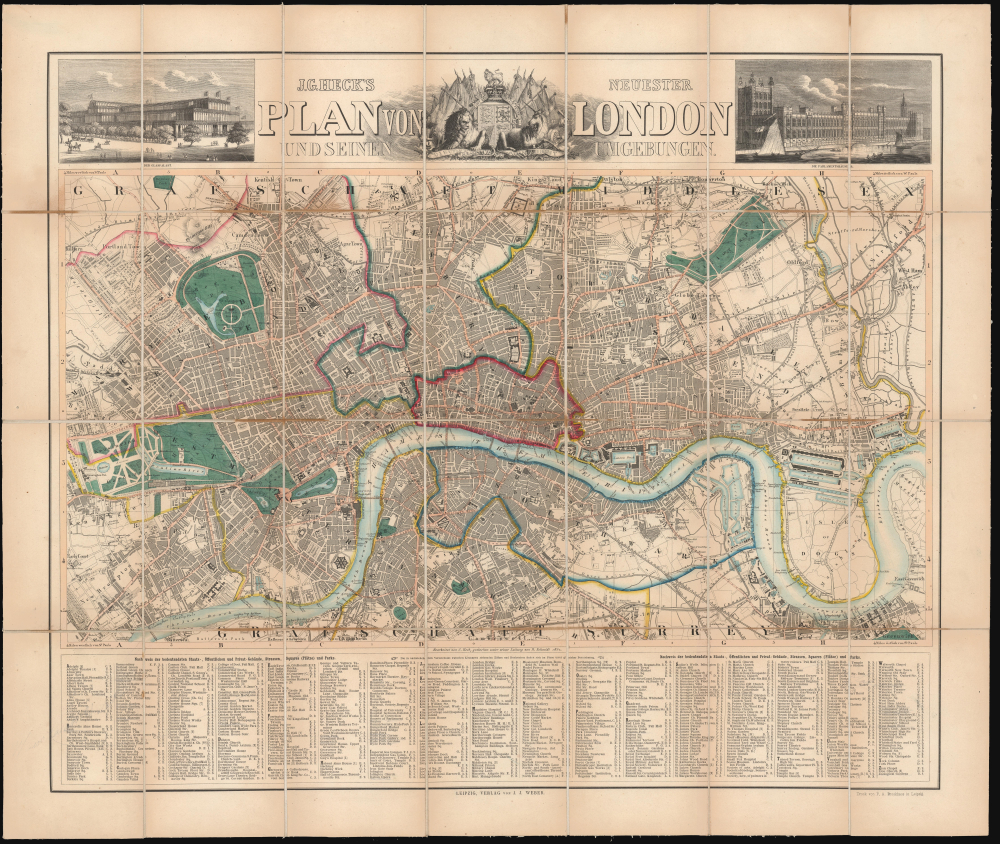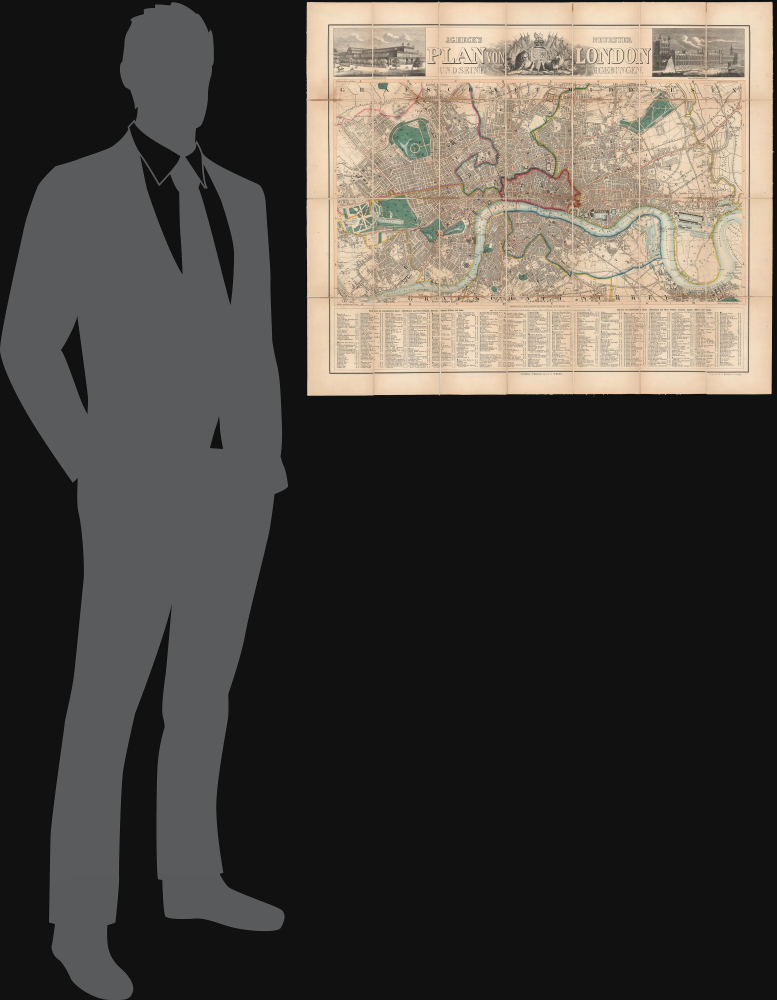Digital Image: 1851 Heck German City Plan of London, Great Exhibition
London-heck-1851_d
Title
1851 (dated) 25 x 29.5 in (63.5 x 74.93 cm) 1 : 19500
Description
FOR THE ORIGINAL ANTIQUE MAP, WITH HISTORICAL ANALYSIS, CLICK HERE.
Digital Map Information
Geographicus maintains an archive of high-resolution rare map scans. We scan our maps at 300 DPI or higher, with newer images being 600 DPI, (either TIFF or JPEG, depending on when the scan was done) which is most cases in suitable for enlargement and printing.
Delivery
Once you purchase our digital scan service, you will receive a download link via email - usually within seconds. Digital orders are delivered as ZIP files, an industry standard file compression protocol that any computer should be able to unpack. Some of our files are very large, and can take some time to download. Most files are saved into your computer's 'Downloads' folder. All delivery is electronic. No physical product is shipped.
Credit and Scope of Use
You can use your digial image any way you want! Our digital images are unrestricted by copyright and can be used, modified, and published freely. The textual description that accompanies the original antique map is not included in the sale of digital images and remains protected by copyright. That said, we put significant care and effort into scanning and editing these maps, and we’d appreciate a credit when possible. Should you wish to credit us, please use the following credit line:
Courtesy of Geographicus Rare Antique Maps (https://www.geographicus.com).
How Large Can I Print?
In general, at 300 DPI, you should at least be able to double the size of the actual image, more so with our 600 DPI images. So, if the original was 10 x 12 inches, you can print at 20 x 24 inches, without quality loss. If your display requirements can accommodate some loss in image quality, you can make it even larger. That being said, no quality of scan will allow you to blow up at 10 x 12 inch map to wall size without significant quality loss. For more information, it is best consult a printer or reprographics specialist.
Refunds
If the high resolution image you ordered is unavailable, we will fully refund your purchase. Otherwise, digital images scans are a service, not a tangible product, and cannot be returned or refunded once the download link is used.
Cartographer S
Johann Georg Heck (1795 - November 20, 1857) was a German engraver, cartographer, geographer, writer, lithographic printer, and publisher based in Leipzig. Heck was born in Strasbourg; little is known of his training but he became involved in the new technology of lithographic printing and was made head of the lithographic department at the Freiburger Kunstinstituts, founded by Bartholomä Herder (1774 - 1839). Heck remained at the institute until 1828, after which he managed a German-French bookstore in Paris and then headed the Paris branch of the publisher Herder and Cie. In 1834, he married Johanna Herder (1803 - 1887), the daughter of Bartholomä Herder. He was best known for several reference works that were published in English and French as well as German, especially his ten-volume Bilder-Atlas zum Conversations-Lexikon. Ikonographische Encyclopädie der Wissenschaften und Künste (published by F. A. Brockhaus), with 500 steel-engraved plates and more than 12,000 illustrations, which was one of the most popular reference works of the 19th century. He also published geographic atlases and separate issue maps in French, English, and German. More by this mapmaker...
Friedrich Arnold Brockhaus (May 4, 1772 - August 20, 1823) was a German publisher and editor. He was born in Dortmund and from 1788 - 1793 apprenticed at a mercantile concern in Düsseldorf. He subsequently studied language and literature at the University of Leipzig, then went on to establish a Dortmund-based concern importing and selling English goods. He developed his business in Amsterdam for a time before economic pressures forced him to close. He turned to publishing, founding 'F. A. Brockhaus', in 1805. The firm was initially based in Amsterdam, but in 1811 relocated to Altenburg, Germany, then, in 1818, to Leipzig. There he established a large printing house dedicated to encyclopedias, scientific publications, and literature. Friedrich Arnold died in Leipzig in 1823, but the business was taken over by his sons, Friedrich Brockhaus (1800 - 1865), who retired in 1850, and Heinrich Brockhaus (1804 - 1874), under whom it was considerably extended. Their most significant publication was the Brockhaus Enzyklopädie, also known as Der Grosse Brockhaus. In 1953, after World War II (1939 - 1945), its Leipzig operations were nationalized by East Germany. Its West German successor established itself in Wiesbaden. Following German reunification, corporate headquarters were moved to Munich. The firm continues to publish as F. A. Brockhaus AG. Learn More...
Johann Jacob Weber (April 3, 1803 - March 1880) was a Swiss book publisher active in Leipzig. Weber was born in Basel apprenticed under bookseller Emanuel Thurneysen. Following his apprenticeship he went on to work with J. J. Pachoud in Genevia, Firmin Didot in Paris, and Breitkopf and Hartel in Leipzing, and Herderian in Freiburg. In 1830 he took work in the Leipzig branch of the Parisian publishing firm of Ange Pere. Four years later, in 1834 he founded his own firm, J. J. Weber, which employed modern printing techniques and was known for sophisticated forward-thinking design work. In 1843 Weber founded the illustrated newspaper Illustrierte Zeitung. The Illustrierte Zeitung was a revolutionary publication for Germany and rekindled a general interest in German printmaking. As a person Weber was said to be of an unpretentious and modest nature who was passionate for his profession. His sons Hermann, John and Felix W. took over the management of the businesses, which continued to be passed down in the family. The firm of J. J. Weber remained active well into the 20th century. Learn More...




